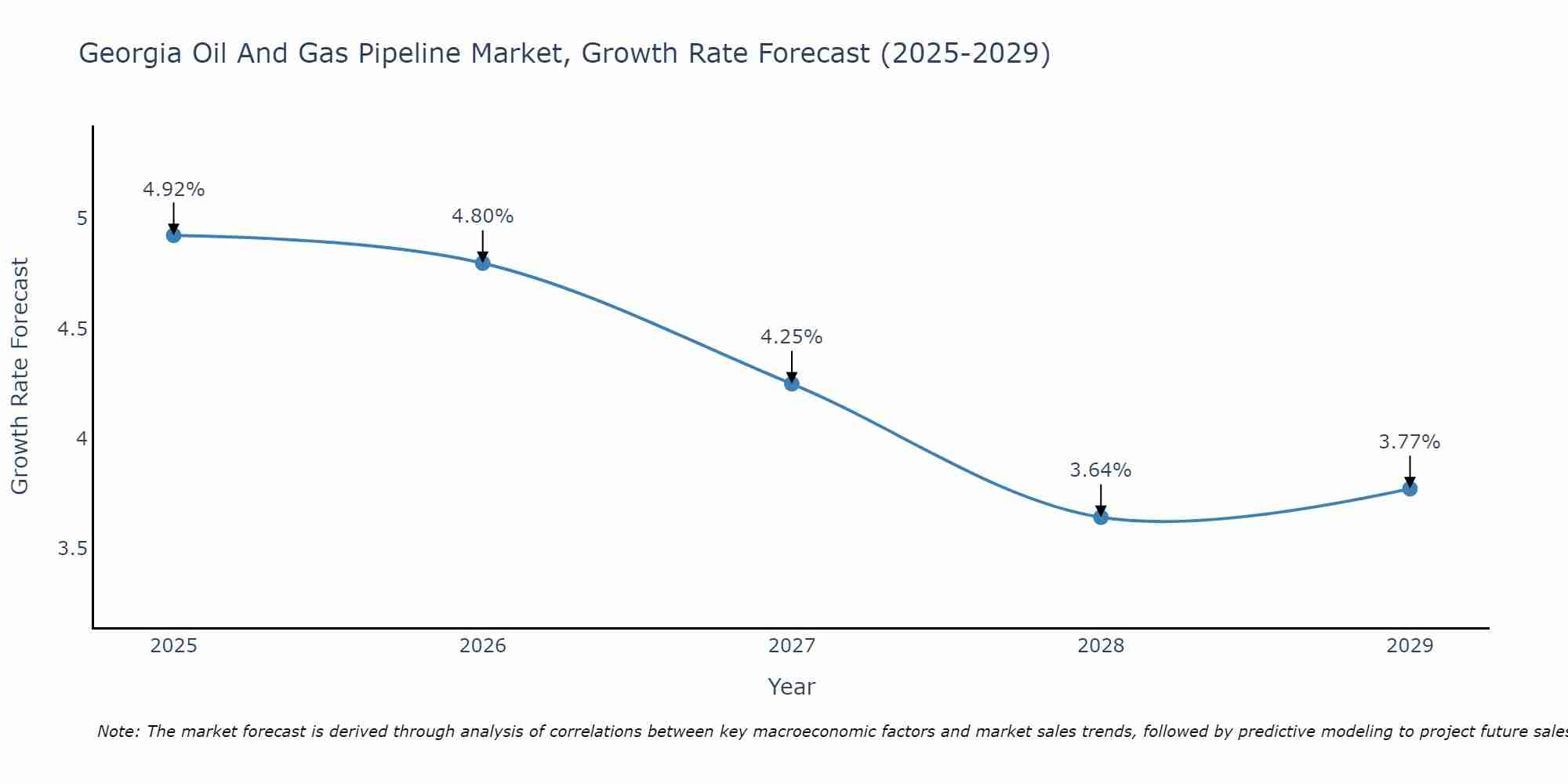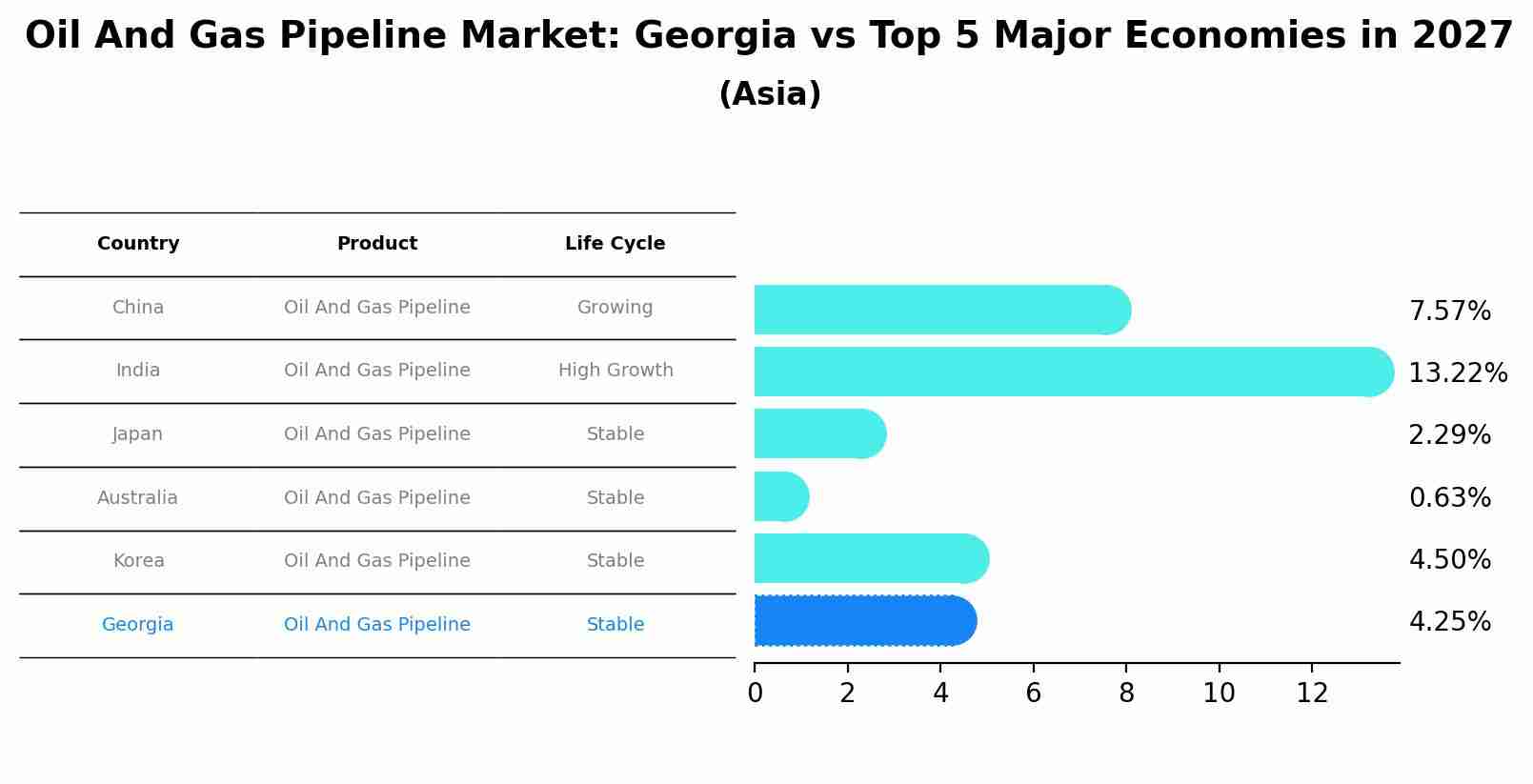Georgia Oil And Gas Pipeline Market Outlook | Analysis, Growth, Size, Industry, Forecast, COVID-19 IMPACT, Value, Trends, Share, Companies & Revenue
| Product Code: ETC377340 | Publication Date: Aug 2022 | Updated Date: Jul 2025 | Product Type: Market Research Report | |
| Publisher: 6Wresearch | Author: Dhaval Chaurasia | No. of Pages: 75 | No. of Figures: 35 | No. of Tables: 20 |
Georgia Oil And Gas Pipeline Market Size Growth Rate
The Georgia Oil And Gas Pipeline Market is projected to witness mixed growth rate patterns during 2025 to 2029. Starting high at 4.92% in 2025, the market steadily declines to 3.77% by 2029.

Oil And Gas Pipeline Market: Georgia vs Top 5 Major Economies in 2027 (Asia)
In the Asia region, the Oil And Gas Pipeline market in Georgia is projected to expand at a stable growth rate of 4.25% by 2027. The largest economy is China, followed by India, Japan, Australia and South Korea.

Georgia Oil And Gas Pipeline Market Synopsis
The Georgia oil and gas pipeline market is a crucial component of the country`s energy infrastructure, facilitating the transportation of crude oil, natural gas, and refined petroleum products. The market is characterized by a network of pipelines that span across the country, connecting production areas to refineries, distribution centers, and export terminals. Major players in the market include companies such as BP, Gazprom, and Socar, which operate key pipelines like the Baku-Tbilisi-Ceyhan (BTC) and the South Caucasus Pipeline. With Georgia serving as a strategic transit country for energy resources from the Caspian region to Europe, the oil and gas pipeline market plays a significant role in ensuring energy security and supply diversification for both Georgia and the broader region. Ongoing developments in the market focus on expanding pipeline capacity, enhancing safety measures, and promoting sustainable practices.
Georgia Oil And Gas Pipeline Market Trends
The Georgia Oil and Gas Pipeline market is witnessing several key trends, including a growing focus on pipeline safety and environmental sustainability. With an increased emphasis on reducing carbon emissions and transitioning towards cleaner energy sources, there is a rising demand for pipeline infrastructure that adheres to strict safety standards and minimizes environmental impact. Additionally, advancements in technology such as pipeline monitoring systems and leak detection technologies are becoming more prevalent in the market to enhance operational efficiency and ensure regulatory compliance. The market is also seeing a rise in investments in pipeline infrastructure expansion to meet the growing energy demand in the region while also integrating renewable energy sources into the existing pipeline networks to support the transition towards a more sustainable energy future.
Georgia Oil And Gas Pipeline Market Challenges
In the Georgia oil and gas pipeline market, challenges include regulatory complexities, environmental concerns, and geopolitical factors. The regulatory landscape can be intricate, with varying requirements at the local, state, and federal levels, leading to delays and increased costs for pipeline projects. Environmental concerns such as potential spills and impacts on local ecosystems are also significant challenges, with communities and environmental groups often opposing pipeline construction. Geopolitical factors, such as regional conflicts or changing international relations, can introduce uncertainty and affect the security and stability of oil and gas supplies through pipelines in the region. Navigating these challenges requires careful planning, stakeholder engagement, and adherence to stringent regulations to ensure the successful development and operation of oil and gas pipelines in Georgia.
Georgia Oil And Gas Pipeline Market Investment Opportunities
Investment opportunities in the Georgia Oil and Gas Pipeline Market are promising due to the country`s strategic location as a transit hub for energy resources between the Caspian Sea and Europe. With ongoing projects such as the Southern Gas Corridor and increased demand for natural gas in the region, there is a growing need for pipeline infrastructure development. Investors can consider opportunities in pipeline construction, maintenance, and operation services, as well as investment in existing pipeline assets or joint ventures with local companies. The favorable regulatory environment and government support for energy infrastructure projects further enhance the attractiveness of investing in the Georgia Oil and Gas Pipeline Market, offering long-term potential for growth and returns. However, potential investors should carefully assess risks related to geopolitical factors, regulatory changes, and market competition before making investment decisions.
Jordan Agar Market Government Policies
Government policies related to the Georgia Oil and Gas Pipeline Market are primarily aimed at ensuring the safety, security, and environmental protection of pipelines within the state. The Georgia Public Service Commission (PSC) regulates intrastate pipelines and oversees compliance with safety standards and environmental regulations. Additionally, the state government has laws in place to prevent unauthorized construction and operation of pipelines, as well as to address emergency response protocols in case of pipeline incidents. The Georgia Environmental Protection Division (EPD) works alongside the PSC to monitor and enforce environmental standards for pipeline projects to minimize the impact on local ecosystems. Overall, these policies aim to maintain the integrity of the oil and gas pipeline infrastructure in Georgia while safeguarding public health and the environment.
Georgia Oil And Gas Pipeline Market Future Outlook
The future outlook for the Georgia Oil and Gas Pipeline Market appears promising due to the country`s strategic location as a transit hub for energy resources between Europe and Asia. With ongoing infrastructure development projects and increasing investments in the energy sector, the demand for oil and gas pipelines is expected to grow steadily in the coming years. Additionally, the government`s efforts to enhance energy security and diversify energy sources are likely to further drive the expansion of the pipeline market. However, challenges such as regulatory hurdles, environmental concerns, and geopolitical risks may pose obstacles to market growth. Overall, the Georgia Oil and Gas Pipeline Market is poised for growth, supported by favorable market conditions and the country`s strategic position in the global energy landscape.
Key Highlights of the Report:
- Georgia Oil And Gas Pipeline Market Outlook
- Market Size of Georgia Oil And Gas Pipeline Market, 2021
- Forecast of Georgia Oil And Gas Pipeline Market, 2031
- Historical Data and Forecast of Georgia Oil And Gas Pipeline Revenues & Volume for the Period 2018 - 2031
- Georgia Oil And Gas Pipeline Market Trend Evolution
- Georgia Oil And Gas Pipeline Market Drivers and Challenges
- Georgia Oil And Gas Pipeline Price Trends
- Georgia Oil And Gas Pipeline Porter's Five Forces
- Georgia Oil And Gas Pipeline Industry Life Cycle
- Historical Data and Forecast of Georgia Oil And Gas Pipeline Market Revenues & Volume By Location of Deployment for the Period 2018 - 2031
- Historical Data and Forecast of Georgia Oil And Gas Pipeline Market Revenues & Volume By Onshore for the Period 2018 - 2031
- Historical Data and Forecast of Georgia Oil And Gas Pipeline Market Revenues & Volume By Offshore for the Period 2018 - 2031
- Historical Data and Forecast of Georgia Oil And Gas Pipeline Market Revenues & Volume By Type for the Period 2018 - 2031
- Historical Data and Forecast of Georgia Oil And Gas Pipeline Market Revenues & Volume By Crude Oil Pipeline for the Period 2018 - 2031
- Historical Data and Forecast of Georgia Oil And Gas Pipeline Market Revenues & Volume By Gas Pipeline for the Period 2018 - 2031
- Georgia Oil And Gas Pipeline Import Export Trade Statistics
- Market Opportunity Assessment By Location of Deployment
- Market Opportunity Assessment By Type
- Georgia Oil And Gas Pipeline Top Companies Market Share
- Georgia Oil And Gas Pipeline Competitive Benchmarking By Technical and Operational Parameters
- Georgia Oil And Gas Pipeline Company Profiles
- Georgia Oil And Gas Pipeline Key Strategic Recommendations
Frequently Asked Questions About the Market Study (FAQs):
- Single User License$ 1,995
- Department License$ 2,400
- Site License$ 3,120
- Global License$ 3,795
Search
Related Reports
- ASEAN Bearings Market (2025-2031) | Strategy, Consumer Insights, Analysis, Investment Trends, Opportunities, Growth, Size, Share, Industry, Revenue, Segments, Value, Segmentation, Supply, Forecast, Restraints, Outlook, Competition, Drivers, Trends, Demand, Pricing Analysis, Competitive, Strategic Insights, Companies, Challenges
- Europe Flooring Market (2025-2031) | Outlook, Share, Industry, Trends, Forecast, Companies, Revenue, Size, Analysis, Growth & Value
- Saudi Arabia Manlift Market (2025-2031) | Outlook, Size, Growth, Trends, Companies, Industry, Revenue, Value, Share, Forecast & Analysis
- Uganda Excavator, Crane, and Wheel Loaders Market (2025-2031) | Strategy, Consumer Insights, Analysis, Investment Trends, Opportunities, Growth, Size, Share, Industry, Revenue, Segments, Value, Segmentation, Supply, Forecast, Restraints, Outlook, Competition, Drivers, Trends, Demand, Pricing Analysis, Competitive, Strategic Insights, Companies, Challenges
- Rwanda Excavator, Crane, and Wheel Loaders Market (2025-2031) | Strategy, Consumer Insights, Analysis, Investment Trends, Opportunities, Growth, Size, Share, Industry, Revenue, Segments, Value, Segmentation, Supply, Forecast, Restraints, Outlook, Competition, Drivers, Trends, Demand, Pricing Analysis, Competitive, Strategic Insights, Companies, Challenges
- Kenya Excavator, Crane, and Wheel Loaders Market (2025-2031) | Strategy, Consumer Insights, Analysis, Investment Trends, Opportunities, Growth, Size, Share, Industry, Revenue, Segments, Value, Segmentation, Supply, Forecast, Restraints, Outlook, Competition, Drivers, Trends, Demand, Pricing Analysis, Competitive, Strategic Insights, Companies, Challenges
- Angola Excavator, Crane, and Wheel Loaders Market (2025-2031) | Strategy, Consumer Insights, Analysis, Investment Trends, Opportunities, Growth, Size, Share, Industry, Revenue, Segments, Value, Segmentation, Supply, Forecast, Restraints, Outlook, Competition, Drivers, Trends, Demand, Pricing Analysis, Competitive, Strategic Insights, Companies, Challenges
- Israel Intelligent Transport System Market (2025-2031) | Strategy, Consumer Insights, Analysis, Investment Trends, Opportunities, Growth, Size, Share, Industry, Revenue, Segments, Value, Segmentation, Supply, Forecast, Restraints, Outlook, Competition, Drivers, Trends, Demand, Pricing Analysis, Competitive, Strategic Insights, Companies, Challenges
- Uganda Precast and Aggregate Market (2025-2031) | Strategy, Consumer Insights, Analysis, Investment Trends, Opportunities, Growth, Size, Share, Industry, Revenue, Segments, Value, Segmentation, Supply, Forecast, Restraints, Outlook, Competition, Drivers, Trends, Demand, Pricing Analysis, Competitive, Strategic Insights, Companies, Challenges
- Australia IT Asset Disposal Market (2025-2031) | Strategy, Consumer Insights, Analysis, Investment Trends, Opportunities, Growth, Size, Share, Industry, Revenue, Segments, Value, Segmentation, Supply, Forecast, Restraints, Outlook, Competition, Drivers, Trends, Demand, Pricing Analysis, Competitive, Strategic Insights, Companies, Challenges
Industry Events and Analyst Meet
Our Clients
Whitepaper
- Middle East & Africa Commercial Security Market Click here to view more.
- Middle East & Africa Fire Safety Systems & Equipment Market Click here to view more.
- GCC Drone Market Click here to view more.
- Middle East Lighting Fixture Market Click here to view more.
- GCC Physical & Perimeter Security Market Click here to view more.
6WResearch In News
- Doha a strategic location for EV manufacturing hub: IPA Qatar
- Demand for luxury TVs surging in the GCC, says Samsung
- Empowering Growth: The Thriving Journey of Bangladesh’s Cable Industry
- Demand for luxury TVs surging in the GCC, says Samsung
- Video call with a traditional healer? Once unthinkable, it’s now common in South Africa
- Intelligent Buildings To Smooth GCC’s Path To Net Zero













